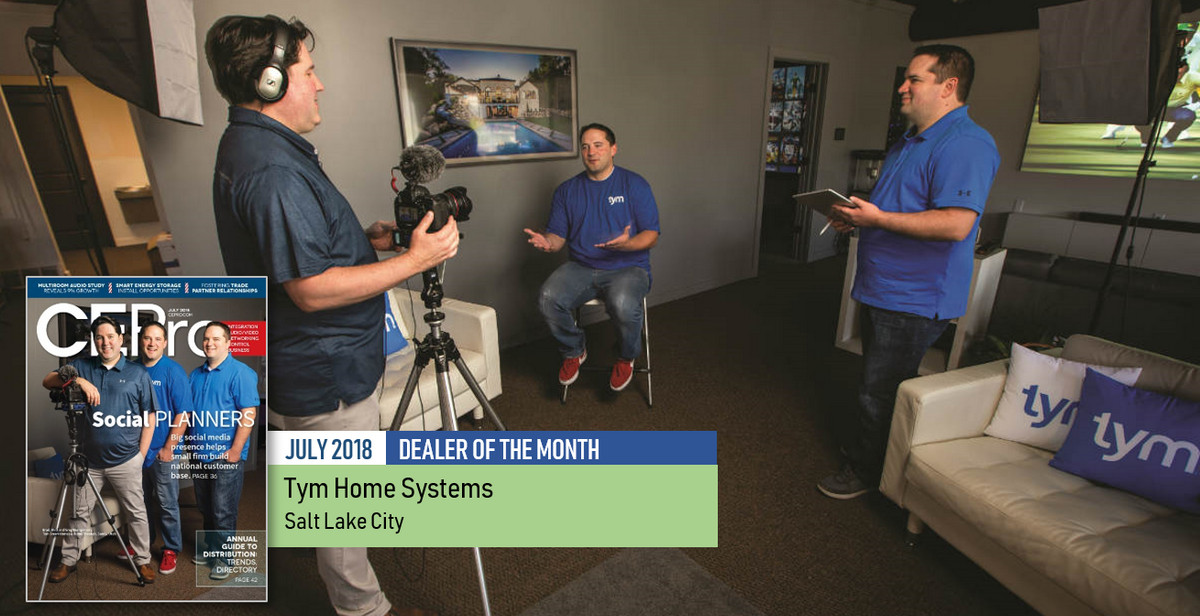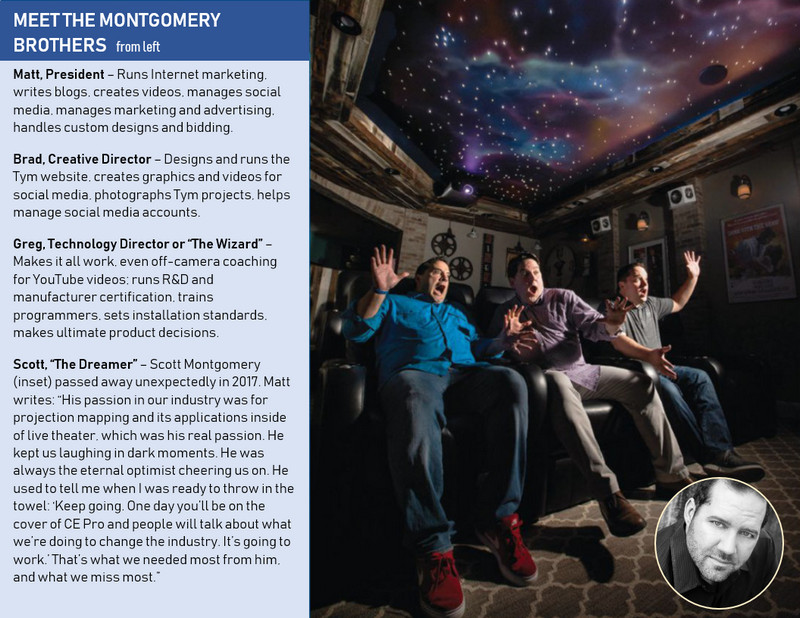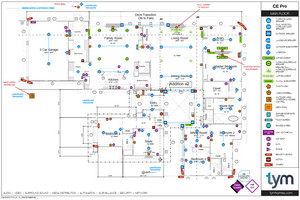For Utah-based Tym Smart Homes & Home Theaters, social media engagement is the digital equivalent of door-to-door sales, according to the former Vivint sales reps.

If you’ve been on the Internet lately, chances are you’ve bumped into Tym Smart Homes & Home Theaters, the integration company led by brothers Matt, Greg and Brad Montgomery. They’re based in Sandy, Utah, but can be found everywhere — YouTube, Twitter, Instagram, Facebook, plus the pages of CE Pro and other trade publications.
They attend all the big industry tradeshows, crank out product reviews and how-to videos, and manage to do their day jobs, too — selling and installing integrated home systems from the mundane to the magnificent, and winning plenty of industry accolades in the process.
All of this with just seven full-time employees. How do they do it?
The Montgomery brothers got their start in the custom-installation business going door-to-door selling for Vivint, the Salt Lake City security and home-automation giant.
The gig frustrated them at the time, not because of the door-to-door slog but because in the early days of Vivint (APX at the time) the company sold only security systems, and homeowners wanted home automation to go with it.
Quick Stats
- Company: Tym Smart Homes & Home Theaters
- Location: Sandy, Utah
- Website: tymhomes.com
- Revenues (2018e): $1.8 million
- Years in business: 9
- Number of employees: 7
- Specialty: Whole-house integration from production homes to high-end custom in the Utah area, plus national coverage through remote systems design.
- Top 5 Brands: Control4, Savant, Luxul, Paradigm, TruAudio
“Security was boring,” says Matt Montgomery, president of Tym. “They [customers] wanted cameras and smart thermostats.”
Matt’s techy brother Greg said, “I could do that.”
And that they did, founding Tym in 2009 with brother Brad and selling 2GIG security and home-automation systems door to door. In the first four months of business, the trio sold 1,200 systems and made $1.3 million.
Tym planned to expand the business but they “loathed” the door-to-door model, according to Matt: “The second they [salespeople] get lazy, you lose money.”
What they needed, he says, was a “digital equivalent” to door-to-door sales. “Digital never sleeps.”
Digital Door-to-Door
Just as the Montgomerys had the very best training on selling door-to-door literally, the brothers set about getting the best training on digital door-to-door, attending seminars and reading everything they could get their hands on.
But everything they could find about online sales seemed to revolve around selling information, not selling product. So they decided to sell information in the form of “how to wire your home.”
In 2016, Tym’s Prewire and System Design service was born. Online customers would send in their floorplans and low-voltage wish lists, and for $295 Tym would mark up the drawings with color-coded wiring diagrams and include a parts list and instructions to boot.
If the customer wasn’t keen on wire-shopping, Tym was all too happy to drop-ship bulk wire and all the accessories — mud rings, low-voltage cans, the works — through a dealer program with Metra Home Theater.
(Click for full image)
The program has evolved since then. Now the standard service is $495, and the online shopper gets a little bit more … and a little bit less. Instead of designing to a customer’s “specifications,” Tym simply packs any given floorplan with every wiring contingency, assuming whole-house audio, security, lighting controls, surround-sound, networking, and other standard technologies will be installed.
While they’re at, Tym includes plans for a Control4 or Savant home automation system and offers, at the customer’s request, a parts list and retail pricing for these systems.
At the end of the day, what the customer gets is pretty much a blueprint for a bid or a DIY project or some combination thereof — for just $495 — from pros who have installed thousands of systems over the years.
Sounds too cheap to be true? Actually, the all-in method is more efficient for Tym than drawing basic wiring diagrams according to customer requests. Turns out, customers didn’t know what to request in the first place.
“We would get these five-page Word documents,” Matt says. “Right now, we just give you the works.”
Customers can then slash unnecessary elements on their own time. In this way, Tym can deliver a service that is, ironically, more customized and yet more standardized — a key theme in all aspects of Tym’s business.
“It’s all so templated,” Matt says.
Whether they plan to perform the work themselves or farm it out to pros, the clients represent some serious purchasing power. Cranking out $495 system designs and drop-shipping structured wiring, however, isn’t Tym’s end game. What the company has learned in this second phase of its online design service is that once customers get to this part of their project, they are pretty serious prospects.
More than a few have requested Tym do the installation, no matter the travel costs. Others want the company to bundle the components for self-installation. Of the 12 to 15 designs Tym does each month, Matt says, about 20 percent lead to bigger things.
Often, by the time a client gets to the purchasing phase, he says, “they’re in a pinch,” so it’s easiest to buy the goods from the company that designed the infrastructure in the first place.
Ultimately, when the goods arrive, sometimes it’s just easier to have that same company install the products, even if it means spending a few thousand dollars in airfare and labor to get it done.
“By the time they decide to do it, they’re all-in on us,” Matt says.
Scaling the Self-Help Business
Tym has no intention of zipping around the country to install these solutions for do-it-yourself intenders who become do-it-for-me realists. In the case of prewire-only designs, an online client can fairly simply find an electrical contractor or low-voltage installer to follow the diagrams and instructions Tym creates.
But as Tym rolls out more sophisticated systems for self-installation, the company will need to make it simpler for (potential) DIY customers to install the systems themselves or hire an appropriate contractor for the job. Tym is now working on that very thing, creating instructional videos for installers — whether amateurs, pros or hybrid — and honing product offerings for efficient packaging.
The more empowered the client, and the more templated the offerings, the more scalable the business model.
“These systems would be prefabricated,” Matt explains. “The idea is that we assemble the rack, preprogram the system, and offer remote support and guidance for the installation and ongoing service.”
Based on “the numbers we’re seeing,” he says, the company is confident it could sell roughly 40 to 50 modest Control4 and Savant jobs per month this way.
“Whether or not we can manage the bandwidth, and scale both in manpower and in a way that makes sense financially, is still to be determined,” Matt adds. “We may discover a small handful of jobs is all we can handle, but I’d like to believe we could manage a larger volume.”
Building a Better ‘Call to Action’

The idea is not preposterous. It’s not even implausible if you look at the security industry — which Tym does again and again.
Tym intends to take a popular DIY/DIFM model in that industry, and apply it to the smart-home market. Several years ago, many traditional security dealers began offering online platforms whereby consumers select the basic security and automation products they wanted for their homes through a simple configuration wizard.
The dealer preconfigures all the devices at their offices, shipping them to the customer with precise installation instructions. When the work is done at the premises, the customer calls the dealer to commission the system, and then the dealer collects fees every month for security monitoring, interactive services and customer support.
Matt goes back to Vivint and its predecessor APX, noting that while the company is exceptional at sales, the business really took off when it pioneered same-day installation. “It seems commonplace, but at the time no one was doing it, and people thought APX was crazy for trying it,” he says.
It was the efficiency of the installation and the immediacy of the customer experience that really drove the business, he believes. And that was before today’s on-demand era.

The Best Kind of Customers
It might seem that shoppers who buy a prewire or design service online would be the worst kind of customers — cheapskates and amateurs who could suck the time (and profits) out of a small integration firm.
Au contraire. These customers are among the best, according to Brad Montgomery.
Customers who walk in “off the street” are still getting educated, and if you’re not the biggest game in town — Tym isn’t — then prospects have no reason to trust your ethics or your expertise.
“If someone walks through the door, they question everything we say,” Brad explains. “It’s a very different client we’re seeing online. They’re finding us because they’ve done homework. Once they get to us, they’ve already read everything.”
Tym is everywhere online, covering trade shows, presenting product reviews, and showcasing their award-winning home theaters. The company’s top YouTube video, “How to Wire a Smart Home,” has generated 30,000 views.
Unlike most integrators (and businesses), Tym doesn’t treat social media as an aside, but as a key part of its overall strategy to appear as national authorities in order to generate not just page views but customers, and not just customers but the very best kind of customers.
The kind of customers that purchase Tym’s semi-custom wiring diagrams and pre-engineered systems online aren’t necessarily out to save a buck. By the time they get there, they’ve scoured Tym’s credentials and see the company as an authority.
“I think they’re just overwhelmed,” Matt says. “They aren’t happy with the answers they’ve been given. They just want an unbiased opinion.”
Back in Utah, Tym continues to run its business as usual, completing about 15 to 20 custom jobs per year and up to 200 production homes through work with builders.

![]()
About the Author

Julie Jacobson, recipient of the 2014 CEA TechHome Leadership Award, is co-founder of EH Publishing, producer of CE Pro, Electronic House, Commercial Integrator, Security Sales and other leading technology publications. She currently spends most of her time writing for CE Pro in the areas of home automation, security, networked A/V and the business of home systems integration. Julie majored in Economics at the University of Michigan, spent a year abroad at Cambridge University, earned an MBA from the University of Texas at Austin, and has never taken a journalism class in her life. She’s a washed-up Ultimate Frisbee player currently residing in Carlsbad, Calif. Email Julie at jjacobson@ehpub.com
Follow Julie on social media:
Twitter · LinkedIn · Google+
Julie also participates in these groups:
LinkedIn · Google+


